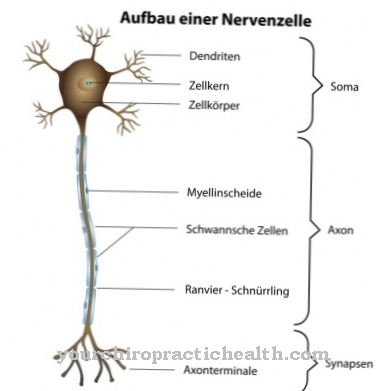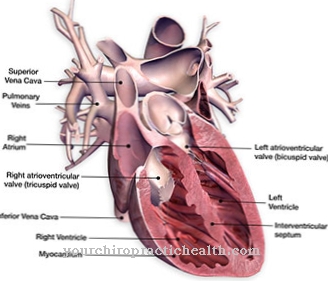With the also as Keratitis designated Corneal inflammation it is an inflammatory change in the cornea of the eye. It is associated with pain, decreased tearing, increased sensitivity to light, and reduced vision. In most cases the corneal inflammation heals without any consequences - however, if treatment is not carried out over a longer period of time, a transplant may even be necessary.
What is corneal inflammation?

© scio21 - stock.adobe.com
The cornea of the eye is, in normal condition, a clear tissue made up of several layers. Their inflammation can be caused by various causes. The degree of this Corneal inflammation varies from case to case, extends only to one or more layers of the cornea.
If it is restricted to the surface, it is mainly characterized by a slight cloudiness. This cloudiness becomes denser the more layers are affected. Since the condition of the cornea has a significant effect on eyesight, timely treatment of the disease is imperative.
This is the only way to prevent severe scarring or corneal detachment and to enable the corneal inflammation to heal without complications.
causes
Typical triggers for Corneal inflammation are infections caused by bacteria or viruses, fungal infections, hereditary predispositions and injuries to the eye. In addition, the inflammation can also appear as a side effect of an underlying disease such as diabetes mellitus or an HIV infection.
Caution in dealing with other people is always required if the corneal inflammation was triggered by an infection: the respective pathogen can be transmitted. A streptococci, Pseudomonas, staphylococci or chlamydia are often associated with such an inflammation.
Herpes or adenoviruses are also known to cause inflammatory changes in the cornea. On the other hand, infestation with fungi is rarer. In addition to the causes already mentioned, corneal inflammation can also be caused by dry eyes, chemical burns or the influence of UV rays.
Symptoms, ailments & signs
A number of different symptoms can occur with corneal inflammation. They vary greatly depending on the specific cause of the keratitis and can be of different intensity. A typical sign of corneal inflammation is severe eye pain. These are usually associated with impaired vision and a more light-sensitive eye.
If the person concerned looks directly into the light, the symptoms increase significantly. A persistent foreign body sensation in the affected eye is also characteristic of keratitis. As a result, those affected often narrow their eyes reflexively. There is an eyelid spasm (blepharospasm). This is accompanied by strong tears and possibly watery or purulent secretion flow.
The eye is usually noticeably reddened. While at the beginning of the disease only cloudiness can be seen in the eye, in the advanced stage a particularly distinctive reddening can be seen. In some cases, tissue damage or growths on the cornea are also visible. In the case of hereditary corneal inflammation (keratitus bullosa), the cornea of the eye may lift off like a bubble. There is a risk of these vesicles bursting, which can lead to further pain.
Diagnosis & course
Since the Corneal inflammation is usually associated with pain, impaired vision and significantly reduced tear flow, most people see a doctor within a very short time. This is an important and essential step because of the consequences of prolonged non-treatment.
To make a diagnosis, the doctor uses various examination methods. The initial suspicion arises from the questioning of the patient and the symptoms of the disease. With the help of the special lighting of a flashlight, the eye is then subjected to a detailed examination, which makes changes inside the eyeball recognizable.
Blistering, growth, corneal detachment and damage as well as opacities can be clearly identified. The examination known as the Schirmer test, with which the flow of tears can be determined, can also contribute to the diagnosis.A swab of the conjunctiva also provides the doctor with information about whether it is an infectious corneal inflammation and which pathogen triggered it
If the disease is recognized and treated in good time, it can be expected to heal without consequences. However, if there is no treatment for a longer period of time, the corneal inflammation can have far-reaching consequences and may even require a transplant.
Complications
The inflammation of the cornea causes pain in the eye in most cases. This pain also occurs in the form of resting pain and can therefore have a very negative effect on the everyday life of the person concerned. It is not uncommon for this to lead to irritability and to psychological complaints and depression. Pain at rest can also lead to difficulty sleeping at night.
The corneal inflammation also has a negative effect on the patient's eyesight. In the worst case, the patient can become completely blind. The eye's sensitivity to light also increases. The eyes are dry and the flow of tears is greatly reduced. This can lead to complications if there is a foreign object in the eye and insufficient tear flow is available. The cornea is usually clouded by the inflammation.
As a rule, there are no particular complications in the treatment. Corneal inflammation is treated with the help of antibiotics and other drugs and leads to success relatively quickly. You may also need eye drops to treat the inflammation. The disease does not affect the patient's life expectancy. After the treatment, the symptoms usually go away completely.
When should you go to the doctor?
If symptoms such as sensitivity to light, visual disturbances, and eye pain occur, the underlying cause may be corneal inflammation. A doctor should be consulted if the symptoms persist for more than a few days. If there are any further signs of corneal inflammation, it is best to consult your ophthalmologist immediately. Contact lens wearers should remove the contact lenses immediately and protect their eyes from further irritation. Medical advice is required at the latest when a white or gray cloudiness is noticed on the corneal surface.
Other warning signs are purulent discharge and an increasing feeling of pressure around the eyes. In order to avoid further complications, you must see a doctor immediately with these symptoms. In the event of acute complaints, for example if the eyesight is severely impaired after waking up, the person affected should call the emergency services. People who suffer from immunodeficiency or who have recently contracted a virus infection are particularly at risk. Diabetes, fungal infections and bacterial diseases are also possible triggers. Anyone who belongs to these risk groups should consult a doctor immediately with the symptoms mentioned. In addition to the family doctor, the ophthalmologist is the right contact.
Doctors & therapists in your area
Treatment & Therapy
In what form the treatment of the Corneal inflammation occurs depends largely on the cause of the disease. In the case of infectious inflammation, for example, drugs are administered that are specially tailored to the pathogen identified in the individual case.
This guarantees maximum treatment success within the shortest possible time. Typically, antibiotics such as tetracyclines are prescribed in connection with bacteria, while antivirals are used to fight viruses. Fungal infection should continue to be countered with the administration of antifungal drugs.
The treatment is different if the cause of the corneal inflammation is the dryness of the eyes associated with a reduced flow of tears. Here it is advisable to rely on special massages of the lid margin and, if necessary, to alleviate the symptoms with the help of a tear substitute fluid.
Furthermore, if the corneal inflammation is only a tolerable side effect of an underlying disease, the treatment of this disease is of the utmost importance.
You can find your medication here
➔ Medicines for eye infectionsOutlook & forecast
It is very difficult to give a precise outlook and prognosis in the presence of a corneal inflammation, as this clinical picture occurs in different degrees of severity. Another factor that greatly affects the prognosis is what triggers the inflammation. The earlier an appropriate treatment is initiated, the shorter the duration of the illness or the risk of further complications.
In normal cases, corneal inflammation can be treated very well and effectively, so that a significant improvement can be expected within a few days. More severe infections can take up to two weeks to heal. Medical or drug treatment is necessary for corneal inflammation, otherwise permanent consequential damage can result.
In the worst case, there is a risk of permanent damage to the cornea, with complete blindness in the affected eye. Vision could not be restored even with surgery.
prevention
The creation of a Corneal inflammation can only be counteracted to a small extent due to the diversity of its causes. It has proven to be helpful to observe certain behaviors - such as regular cleaning of contact lenses and their containers as well as protecting the eyes from direct sunlight. If there are typical risk factors, it is also advisable to have the eyes examined at regular intervals.
Aftercare
Close medical care is important after the corneal inflammation. The patient should consult the doctor after a few days so that any complications that may arise can be identified and treated immediately. In the following period, the ophthalmologist should be visited regularly, especially in the case of chronic or severe inflammation that is associated with severe symptoms.
In the case of severe corneal inflammation, the eye should be checked two to three times a week to start with, as there is a high risk of complications. In addition, some rules of conduct must be observed. Do not rub or push around the affected eye.
External stimuli in the form of cold drafts, dust or direct sunlight should also be avoided by protecting the eye with a medical eye patch or other aid. Patients who expose their eyes to greater stress at work should first take sick leave.
The prescribed medication should continue to be used as directed until the inflammation has completely subsided. If unexpected symptoms occur, for example a sudden deterioration in vision or severe pain in the area of the inflammation, a doctor is recommended. In the case of slight complaints, the next check-up can be awaited.
You can do that yourself
If the corneal inflammation was caused by an infection with bacteria, viruses or fungi, the patient must pay more attention to hygiene. Many people regularly grab their faces or rub their eyes. However, these mostly harmless gestures can cause pathogens on the hands to get into the eye and trigger or intensify an infection there. Those affected should therefore wash their hands thoroughly and regularly check their gestures. Anyone who uses contact lenses should clarify with their doctor whether they can be worn despite keratitis or whether glasses must be used.
If the cornea becomes inflamed because the eye does not produce enough natural tear fluid, artificial tears can be used. In addition, people who suffer from dry eyes and work at the screen should take regular breaks and blink vigorously, which stimulates the production of tears. In addition, sufficient humidity at work and at home should be ensured. It often helps to set up large bowls of water and ventilate them regularly. On longer flights, thermal water sprays from the pharmacy, which are also available in handbag format and are usually allowed into the cabin, can provide relief.



.jpg)
.jpg)

.jpg)

















.jpg)



